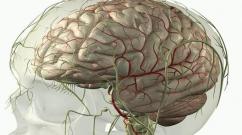What is responsible for a person’s feelings. What are the sense organs? Two ears - to listen better...
Human sense organs: the main organs, what they are responsible for, how they are connected to the brain. Hygiene rules.
Thanks to the presence of sense organs, we can easily adapt to the world around us. What is given from birth and is present to us all our lives is of little value, and if suddenly, due to some accident, we lose one or more feelings, we lose a part of ourselves. Unfortunately, we are not always taught from childhood how important this is, but if you are reading this article, it means that you, like us, have decided to take care of the most important thing in the world - your body!
Let's think about how we feel for a second:
- Close your eyes and imagine how people who do not have such a natural gift live;
- Imagine not hearing the smell of food, the aroma of flowers and the delicious aromas of your beloved family members;
- Think about it, if you could no longer taste your favorite dish or drink;
- Imagine putting your hand in water and it starts to blister, but you don't understand why.
And this is just a small list of the limitations experienced by people whose senses work poorly or do not work at all.
What are human sense organs?
Human senses are the very organs with which a person interacts with the world around him. With the help of the senses, a person can realize what awaits him at one time or another when he comes into contact with the world around him, cognize it and enjoy life.
How many basic sense organs does a person have and how many total sense organs?
Currently, scientists have approved six human senses, but there is constant debate that a person has many more senses and this is only a condensed concept.
The list of human senses includes:
- Ears (thanks to the ears we hear sounds and vibrations);
- Eyes (thanks to the eyes we see);
- Tongue (thanks to this organ we feel the taste and temperature of everything we absorb);
- Nose (the nose helps us hear smells and aromas);
- Skin (they provide tactile sensations, touch, a sense of pain and temperature of the surrounding world);
- Vestibular apparatus (thanks to this sense organ, we realize our place in space, maintain balance and feel weight and position).
5 main senses - taste, vision, hearing, touch, smell: their main functions and significance
In this section I would like to pay attention to each of the senses separately and highlight their significance for human life.
Eyes . With the help of vision we receive on average about 90% of information. The pupils, with the help of which we see, are formed in the embryo and continue to develop until birth, directly connected with the brain.
Vision, or rather visual analysis, consists of several functions:
- Eyeballs;
- Optic nerves;
- Subcortical centers;
- Higher visual centers in the occipital areas.
Can you imagine how long a signal travels in an instant so that we can see and process information in real time without delay? How quickly the eyeballs, having recognized the signal, transmit it to the brain, and the brain instantly analyzes and produces a reaction from what it sees.
In addition, eyeballs are an ideal and unique optical device. Thanks to this, we can see at different distances, and we are also able to see both the whole picture (for example, a room) and the smallest detail (for example, a scratch on furniture).
The principle of operation of the eyes is very simple and at the same time very complex: light passing through the cornea of the eye is refracted and the refracted passes through the lens, where it is refracted again and tends to the vitreous body, where it converges in focus on the retina. It sounds complicated, but you need to know this in order to understand that visual acuity directly depends on the cornea and lens, or rather their ability to perfectly refract light.
But that's not all! Thanks to the muscles located in them, the eyes are able to move in different directions, which significantly increases the speed of vision and also relieves the load on the spine.


Organs of taste . This organ is responsible for taste buds, thanks to which a person can evaluate the food he eats. This protects a person from eating spoiled foods, allows him to enjoy new and familiar tastes, and also tells the brain the most acceptable tastes, and therefore, the brain subsequently signals what kind of food he wants to eat.


There is a misconception that the tongue is responsible for taste, but for some reason they forget to tell you that special nipples and bulbs are located not only on the tongue, but also on the palate, epiglottis, and also on the upper part of the esophagus.
Interesting fact: the tongue is divided into several zones that best determine a particular taste. But even if the zone is not responsible for a given taste, this does not mean that it will not feel it, just not so brightly. Example: the lateral arches of the tongue most clearly sense bitterness, but this does not mean that the rest of the tongue, palate and larynx will not taste pepper.
It is worth noting that the organs of taste are closely interconnected with the organs of charm. For colds and viral diseases Taste habits can change significantly and what gave pleasure can cause persistent disgust. After recovery, the situation will stabilize and return to its previous state.
Ears . It is believed that the most difficult people to adapt to in the world are those who have difficulties with vision and hearing. Indeed, in our fast-paced world it is quite difficult to live without acute hearing, and therefore it is important to carefully take care of what nature has given us.
The ear consists of three interconnected parts: outer, inner and middle. The outside is the familiar shell, which is as individual for everyone as fingerprints. It is responsible for sound localization and also clearly identifies the sound source.


In the external meatus that runs from the outer ear to internal organ, located the sebaceous glands that produce earwax. It is she who, constantly coming out, prevents clogging of the inner ear. This is followed by the eardrum, which responds to sound vibrations. Next comes the tympanic cavity - the basis of the middle ear. In this cavity there is a stapes hammer and anvil connected into a single whole. After them is the cochlea and semicircular canals, which are responsible for balance.
So, auditory waves are caught by the outer ear, move to the eardrum, from there to the three auditory ossicles and then to the cochlea, from the cochlea there is irritation to the auditory nerve and the brain perceives what is heard.
Organs of touch . Most people do not even realize what an important role this function of the body plays. How important it is for us to understand whether we come into contact with hot or cold, smooth, rough, soft or hard. It is tactile sensations that bring endorphins (hormones of joy) when in contact with a loved one. Touching a favorite thing, an animal, and even the outside world can tell us no less than sight! Please note that children who have not yet accumulated enough life experience touch everything and it is through touch that they study the world and gain that very experience.


But it is worth noting that the skin (they are the organs of touch) exclusively “catch” signals and transmit them to the brain, and the brain, having already analyzed it, reports what our fingers felt.
Nose or olfactory organs . In the nasal passages, a small part is occupied by olfactory cells. The shape of the cells resembles many tiny hairs and when moving they capture the subtleties of all kinds of aromas and odors. As with the sense of touch, olfactory cells pick up scents and transmit the signal to the brain, which is already processing the information. Signals are transmitted in this way: olfactory cells capture the aroma and transmit it through olfactory threads and bulbs to the centers of the brain. The sense of smell may be temporarily dulled during viral respiratory diseases and restored within a few days after recovery. Otherwise, the help of doctors is necessary.


The tongue is what sense organ?
The tongue, together with the larynx, palate and other parts of the oral cavity, belongs to the organs of taste. We discussed the taste organs in more detail in the section above.


What sense organs does a person lack?
Many people have a question: what sense organs do humans lack? For science fiction writers, this is simply fertile ground for creating superheroes or, on the contrary, villains. We have identified the most popular sense organs that humans do not have, but if they existed, a person’s life would be much more comfortable.
- The ability to detect ultrasound is a unique gift of bats;
- Clear vision in the dark - the capabilities of cats and more are amazing!
- Electroreceptors with which stingrays and sharks are gifted;
- The lateral line of fish is ideal sensitivity in space, which contributes to both survival and hunting;
- Thermal locators that snakes are gifted with.
This is just a small list of the capabilities of the surrounding world that nature has not endowed us with or that we have lost in the process of evolution.
Sense organs and brain, nervous system: how are they interconnected?
Each sense organ is directly connected by nerve endings to the brain and continuously sends signals. The brain, in turn, analyzes the signals and produces ready-made information. It is worth noting that the brain rarely receives a signal from just one sense organ, and most often in a complex manner. So, for example, a child enters the kitchen and sees food (vision), hears the mother’s voice “Sit down to eat”, feels the aroma of food, sits down at the table and comes into contact with cutlery (a signal that food is about to arrive), and by the time the mother When a child puts a plate on the table, he most likely knows what the dish will taste like.
How do the senses help a person navigate the world?
Have you seen a newborn kitten, how it pokes in different directions, not yet understanding how to navigate in space. Likewise, a person without sense organs would move in space without understanding where he is and how to get to the right place, what needs to be done to avoid getting into trouble.
For example, a sense of balance helps a person understand where the earth is and where the sky is, even in a room without a single window. Also, thanks to this feeling, a person clearly navigates in space, moving in the desired direction without injury.
The hearing organs help to hear not only conversations with family, but also the sound of moving vehicles, running animals, etc. Having analyzed this sound, a person can correctly orient himself even if he does not yet see this object.
Vision in modern life is one of the key senses, because our society is created in such a way that we receive 99% of information visually. According to statistics, people with visual impairments are limited in modern world most strongly.
Thanks to the sense of touch and charm, a person not only experiences the most vivid and pleasant emotions, but can also protect himself from the dangers of our world. For example, repulsive odors signal to us that food is no longer suitable for consumption until it reaches the tongue. The smell of smoke and burning often saves people from fires and allows them to quickly extinguish or leave the room at the stage of fire.
Hygiene rules for the main sense organs
In order for our senses to serve us faithfully for many years, we must respond to them with care and regular care. Below we provide basic hygiene rules for the organs responsible for the senses.
- Organ of touch: all of our skin needs daily cleaning (shower or bath), moisturizing and nourishing as necessary. Particular attention should be paid to the palms and feet, since it is on their integument that the maximum number of receptors that transmit the most important information to the brain is located;
- Olfactory organ: as necessary, it is necessary to rinse and clean the nasal cavities from pollution and substances secreted by the body. In case of illness, treat according to the doctor’s recommendations;
- Organs of taste: the oral cavity needs daily brushing of the teeth, brushing with dental floss if necessary, as well as rinsing the mouth in the morning and evening, as well as after each meal;
- Hearing organs: if there are no problems in the ears, then cleaning the outer ear should be done after washing with cotton swabs or special swabs. In other cases, as necessary, it is necessary to clean out the wax, but only at the entrance to the ear, deeper, like ear plugs, it should be cleaned exclusively by an ENT doctor;
- Eyes: together with the skin, the eyes must be washed morning and evening; if you wear contact lenses, clean them according to the instructions. As tearing, burning, or other unpleasant sensations in the eyes, it is recommended to consult a doctor immediately.
Video: What controls our senses: human anatomy?
Interesting facts about the senses. Part 1.
The human sensory system is both a defense system, a system for perceiving the world, and the ability to fully contact the world. A healthy person has 5 senses. Each has its own functions and purpose.
How are human senses structured and how do they function?
A healthy person has 5 senses. They are divided into two types: remote and contact. The contact organs include the organs of taste and touch: tongue and fingers. Remote ones include: ears, eyes and nose. It is also important to note that disturbances in one place lead to multiple changes in other parts of the body. If you know what is connected with what, you can easily diagnose and eliminate the key causes of the disease. And the symptoms will go away on their own.
This is interesting! When sensitivity is impaired in some organs, others increase their abilities to compensate for a more or less normal perception of the world and protect the body. For example, with complete or partial loss of vision, hearing acuity or sense of touch increases significantly.
Speaking about the senses, it is worth saying that the main thing here is the brain. All others are only intermediaries, because all signals are ultimately transmitted to the brain.
Eyes and their functions
The eyes are responsible for the perception of visual information. They are more closely connected to the brain than other organs. That is why through vision a person perceives greatest number information, and it is processed most quickly by the brain. Therefore, vision is considered the most important means of world perception.
The eyes help to perceive colors and light, objects, allow you to see the world in volume, and have the ability to focus directly on the central object or on the side ones. The eyes provide a wide range of vision. This is also a way of protection. By ear, for example, you can’t always immediately determine exactly where a sound is coming from. And the eyes immediately determine it accurately.
This is interesting!
- Lateral, or peripheral, vision is much better in women than in men. This also explains the ability of men to focus on only one thing, while women can do several at once.
- The eyes have the ability to distinguish up to 500 shades of gray.
- The iris of the eye is as unique as a fingerprint.
Therefore, it is important to protect your eyesight. Natural peptide bioregulators and other NPCRiZ drugs help not only prevent vision deterioration, but also restore it to some extent.
To prevent vision:
- Mesotel Neo;
- Geroprotector Retisil;
- Peptide complex No. 17;
- Peptide bioregulators: Visoluten, Cerluten;
- Bioregulators of vascular and brain functions: Pinealon, Vezugen.
For complex treatment:
Great solution - complex application NPTsRIZ products to solve various vision problems.
Continued in the next article.
Human emotions constitute one of the most complex areas of the psyche. They represent a complex system of elements that allows an individual to constantly feel and experience all the events that happen to him. In this totality, four components are distinguished: emotional tone and states, emotions, feelings.
Feeling as one of the components of the human emotional sphere
A feeling is a special form of human perception of the phenomena of reality, which is characterized by the presence or absence of compliance with human needs, with its characteristic relative stability. Different types feelings allows you to determine a person’s emotional perception of things, phenomena, events, his internal state, and moral beliefs.
All new events that occur in a person’s personal life and his field of activity are perceived by him through his feelings and are expressed in experiences and emotions. For the development of a person as an individual, the formation of feelings is necessary. This is one of the conditions for its development. The formation of feelings is a long process that occurs inseparably from individual development, which is influenced educationally by family, education, culture, social and other factors.
Emotional tone, unlike feelings, is a reaction in the form of an experience that establishes a person's present state. Emotional tone conveys information to the body about the level of satisfaction of current needs. In practice, this is expressed in a person’s definition of events as pleasant and unpleasant. You can determine your emotional tone at any time.
An important component of human life is emotions.
Emotions can be characterized as strong subjective feelings that arise in important situations and events. They are based on needs, therefore events that are indifferent to an individual cannot affect his emotions. Therefore, if a person is interested in any changes in his environment, feeling the need for it, emotions will inextricably accompany his life.

Feelings can be described as the emotional attitude of an individual towards an object or subject. They differ in their subjectivity. Feelings arise through the practical interaction of an individual with the external environment. Their role is quite significant for humans.
The emotional state, unlike feelings, has a weaker focus on the object. Unlike emotions, the emotional state is more stable and lasting. However, thanks to emotions and feelings as mechanisms, it is put into action. The connection between them is strong enough that the emotional state can sometimes be called an emotion. A state of joy, euphoria - shades of one component.
Features and nature of the emergence of the human sensory sphere
Feelings exist in the emotional sphere of a person as an integral component that has direction. They do not arise just like that, but are the result of a relationship to a subject or object. It is quite difficult to list all types of human feelings, primarily because they are similar to mental processes and reflect human personality traits and emotions.
Basic human feelings and their characteristics
Types of feelings are conventionally divided into two categories.
- Moral. These include compassion, love, kindness.
- Aesthetic. Are the result of exposure environment through subtle response. For example, the feeling of beauty.
You can also name such types of human feelings as love, grief, guilt, envy.
Love as one of the most important components of human life
Types of feelings, one of which is love, can be considered from the point of view of psychological processes in the human body. When experiencing this particular feeling, processes arise when a deep attachment to an individual, people, object or objects appears.

The feeling of love from the point of view of philosophical sciences
Love makes a person happy. Love, as an indicator of happiness, belongs to the category of subjective concepts. This concept is one of the fundamental ones in all cultures and art. Ancient philosophical systems and literary sources consider and deeply analyze this concept. Most of the works of writers and famous people. However, most still cannot understand this feeling and the reason for its occurrence.
Is envy a feeling or an emotion?
Today, many are interested in the question of whether envy belongs to emotions or its category - types of feelings.
Envy arises in relation to someone or something. Envy always has an object to which it is directed. Therefore, this concept should be attributed to feelings. It is a painful condition in which a person desires something that does not currently belong to him.

Feeling of grief. This feeling occurs when you lose loved one or important subject. It is accompanied by a number of natural step-by-step processes. First there is shock. It is replaced by detachment. The person feels deep sadness. These feelings are inextricably linked with the desire to cry, an indifferent attitude towards everything, and are often accompanied by a feeling of guilt. The significance of the loss for a person determines the period of return to normal life.
Guilt. This feeling is familiar to many people. Its integral components are self-accusation and condemnation of one’s actions. The feeling of guilt can be called aggression directed at oneself, although, perhaps, the person did not have the intention to commit any negative actions.

A feeling of fear can arise when frightening events, objects, people, or animals appear. It can also be caused by a person’s collision with something unknown that disturbs his peace. The feeling of fear is one of the manifestations of the instinct of self-preservation.
An event or object can cause a feeling of anxiety that develops into fear. The first feeling is a harbinger of the second. At the same time, the body remembers the mechanism of reaction to fear and triggers it if the prerequisites arise. Information about the experienced sensations remains in a person’s memory. Attempts to change unpleasant thoughts and memories most often lead to more stable connections in the human psyche. The emergence of fear begins through a feeling of anxiety with the appearance of an external stimulus.
What are other types of feelings?
Other types of feelings are represented by a combination of such components emotional sphere human beings, such as justice, duty, responsibility, devotion, shame, humor, creative inspiration and others.
Which human organs are responsible for the perception of basic senses?
Human sense organs are anatomical devices that perceive external influences and environmental irritations, which are transformed into a nerve impulse and transmitted to the brain. A person receives information about internal and external changes in the body. Emerging stimuli are converted into nerve impulses through receptors. Their main function is to determine the specifics in such a complex system as the human senses. What are they?
Sense organs are types whose presence allows a person to perceive information through various sources. Moreover, all these organs are interconnected. Scientists include special sense organs among them. These are the eyes, ears, tongue, nose, skin, vestibular apparatus.
Functions of the senses
Their main functions are interconnection, cognition and adaptation to constantly changing conditions of the external environment. They contribute to human adaptation to the world around us. In the primitive world, the functions of the senses were to provide the ability to avoid life-threatening danger and the opportunity to obtain food.

The eyes are a very important sense organ, thanks to which a person has the opportunity to receive about 90% of the total information received. The formation of the visual organs occurs at the stage of embryonic development. Their main function is the perception of information. Then she goes to visual cortex, which allows a person to see and evaluate the information received. The eyes can be thought of as an optical device, the principle of which is similar to a camera.
The ears consist of the outer, middle and inner ear. The outer ear determines the location and sources of sound. The auricle, which represents the outer ear, passes into the auditory canal. The eardrum is the outer wall. The middle ear begins with it. Next comes the tympanic cavity. The inner ear is represented by the cochlea.

Thanks to the sense of smell, a person perceives odors. A small part of the upper nasal spaces is occupied by cells that perceive various odors. Information is transmitted to the bulbs by transmission along the olfactory filaments. Then this information enters the cortical centers of the brain.
The organ of taste allows a person to taste and evaluate food. The tongue contains taste buds that perceive food. A person tastes food much worse when he suffers from a disease of the nasopharynx, which does not allow him to perceive the taste of food fully. This is due to the fact that special sense organs - smell and taste - are closely related to each other. The tongue can be divided into zones, each of which is responsible for the perception of a specific taste. The edge of the tongue allows you to most fully determine whether the product is sour, the middle of the tongue allows you to feel the salt, and the tip - the sweet taste.
The sense of touch also allows a person to perceive the environment. A person feels objects through touch and can determine the structure of its surface, temperature, pain, pressure. A person receives information about this from the brain. It analyzes external signals and assesses how dangerous they are. For example, the desire to quickly withdraw your hand when touching a hot object.
Sense organ
Sense organ- a specialized peripheral anatomical and physiological system that, thanks to its receptors, provides the receipt and primary analysis of information from the outside world and from other organs of the body itself, that is, from the external environment and the internal environment of the body.
Distant sensory organs perceive stimuli at a distance (for example, organs of vision, hearing, smell); other organs (taste and touch) - only with direct contact.
Some senses can complement others to a certain extent. For example, a developed sense of smell or touch can to some extent compensate for poorly developed vision.
Human sense organs
The information received by the human brain from the senses shapes a person’s perception of the world around him and himself.
There is an opinion that there is a sixth sense:
- vestibular apparatus (sense of balance and position in space)
Information about stimuli affecting the receptors of the human senses is transmitted to the central nervous system. She analyzes incoming information and identifies it (sensations arise). Then a response signal is generated, which is transmitted along the nerves to the corresponding organs of the body.
The pathways from the human senses are the vestibular, auditory, visual, olfactory, tactile and gustatory pathways of the central nervous system.
According to popular belief, humans have four other senses:
Thermoception is the feeling of heat (or lack thereof) on our skin.
Equibrioception is a sense of balance that is determined by the fluid-containing cavities in our inner ear.
Nociception is the perception of pain by the skin, joints and organs of the body. Strangely, this does not include the brain, which has no pain-sensitive receptors at all. Headaches - no matter what we think - do not come from inside the brain.
Proprioception - or "body awareness". This is an understanding of where parts of our body are, even we do not feel or see them. Try closing your eyes and swinging your leg in the air. You will still know where your foot is in relation to the rest of your body.
Sense organs in animals
Reaction to external influences (light, temperature, chemicals and other stimuli) in lower organisms is usually caused not by special organs, but common property living matter - irritability.
In higher organisms, information is perceived and transmitted by specialized sensory organs adapted to perceive signals of a certain nature.
During the process of evolution, animals have developed sense organs specific to their lifestyle, such as electroreception, pressure sensation, thermoreception, sensation magnetic field Earth.
See also
Notes
Literature
Wikimedia Foundation. 2010.
Synonyms:See what a “sense organ” is in other dictionaries:
sense organ- nerve devices that serve as receivers of signals informing about changes in external environment(exteroception) and in the subject’s body (interoreception). It is customary to distinguish five external sensory systems: vision, hearing, smell, taste, skin... ...
A concept synonymous with the concepts analyzer, sensory system. There are five sense organs: the organ of vision, the organ of hearing, the organ of taste, the organ of smell, the organ of touch. This list can be expanded to include others morphologically and functionally... ... Psychological Dictionary
Noun, number of synonyms: 5 eyes (65) skin (62) nose (57) ears ... Dictionary of synonyms
- (o. sensuum) O., performing the perception and primary analysis of irritations coming from the environment ... Large medical dictionary
Sense organ- same as Analyzer, sensor system... Trainer's Dictionary
sense organ: specific energy concept- see the concept of specific energy. Dictionary practical psychologist. M.: AST, Harvest. S. Yu. Golovin. 1998 ... Great psychological encyclopedia
A complex of anatomical structures that perceive and analyze various irritations of the external and internal environment. Each analyzer consists of three parts: peripheral (receptors), which perceives the energy of external stimulation and... ... Medical terms
SENSE ORGAN, ANALYZER- (sense organ) a complex of anatomical structures that perceive and analyze various irritations of the external and internal environment. Each analyzer consists of three parts: peripheral (receptors), which perceives the energy of external... ... Dictionary in medicine
A sensory organ that has developed in the process of evolution is a specialized peripheral anatomical and physiological system that, thanks to its receptors, ensures the receipt and primary analysis of information from the surrounding world and from other organs of itself ... ... Wikipedia
The vomeronasal organ (vomeronasal organ, Jacobson's organ, sometimes also vomer) is a peripheral part of the accessory olfactory system of some vertebrates. Its receptor surface is located in the path of inhaled air... ... Wikipedia
Books
- Tablets of the Fiery Epoch, The book “Tablets of the Fiery Epoch” tells about the fiery reorganization of the world, teaches how to handle fiery energies. It is compiled based on materials from the Teaching of Living Ethics, letters and diaries of E.I.... Category:
Human senses are designed to interact with the world around us. A person has five of them:
The organ of vision is the eyes;
The organ of hearing is the ears;
Smell – nose;
Touch - skin;
Taste is the tongue.
They all react to external stimuli.
Organs of taste
Humans have a sense of taste. This occurs due to special cells responsible for taste. They are located on the tongue and are combined into taste buds, each of which has from 30 to 80 cells.
These taste buds are located on the tongue as part of the fungiform papillae, which cover the entire surface of the tongue.
There are other papillae on the tongue that detect various substances. There are several types concentrated there, each of which has its own taste.
For example, salty and sweet are determined by the tip of the tongue, bitter by its base, and sour by the side surface.
Olfactory organ
The olfactory cells are located in the upper part of the nose. Various microparticles enter the nasal passages onto the mucous membranes, due to which they begin to contact the cells responsible for the sense of smell. This is facilitated by special hairs that are located in the thickness of the mucus.
Pain, tactile and temperature sensitivity
The sense organs of a person of this species are very important, because they allow them to protect themselves from various dangers of the surrounding world.
Special receptors are scattered across the surface of our body. Cold responds to cold, heat to heat, pain to pain, tactile to touch.
Most tactile receptors are located in the lips and on the tips of the fingers. There are much fewer such receptors in other parts of the body.
When you touch something, tactile receptors are irritated. Some of them are more sensitive, others less, but all the information collected is sent to the brain and analyzed.
The human senses include the most important organ - vision, through which we receive almost 80% of all information about the outside world. Eye, oculomotor muscles, lacrimal apparatus, etc. are elements of the organ of vision.
The eyeball has several membranes:
The sclera, called the cornea;
The choroid, which passes in front into the iris.
The inside of the eyeball is divided into chambers filled with jelly-like transparent contents. The cameras surround the lens, a transparent disc for viewing objects near and far.
The inner side of the eyeball, which is opposite the iris and cornea, has light-sensitive cells (rods and cones) that convert light into an electrical signal that travels to the brain via the optic nerve.
The lacrimal apparatus is designed to protect the cornea from microbes. The tear fluid continuously washes and moisturizes the surface of the cornea, ensuring its sterility. This is facilitated by occasional eyelash blinking.
The human senses include the hearing organ, which consists of three components - the inner, middle and outer ear. The latter is the auditory concha and the ear canal. Separated from it by the eardrum is the middle ear, which is a small space with a volume of about one cubic centimeter.
The eardrum and inner ear contain three small bones called the malleus, stapes, and incus, which transmit sound vibrations from the eardrum to the inner ear. The sound-receiving organ is the cochlea, which is located in the inner ear.
The snail is a small tube twisted in a spiral in the form of two and a half special turns. It is filled with a viscous liquid. When sound vibrations enter the inner ear, they are transmitted to the fluid, which sways and acts on the sensitive hairs. Information in the form of impulses is sent to the brain, analyzed, and we hear sounds.
- Loading... Currently, customers do not experience a shortage of products on store shelves. On the one hand, this is good, but you can find less and less balanced...
- Loading... Unfortunately, today there are practically no completely healthy people. From time to time, some problems with the body bother everyone. In this article I would like to talk about...
- Loading... All teeth are equipped with nerves. If pain appears, it means that you have not taken good care of your oral cavity. In this case, you cannot do without a trip to the dentist. But...
- Loading... Pain in the left arm is a common symptom of many diseases. Often people consider it a sign of developing heart problems. However, this is not always true...
- Loading... Noodles instant cooking is definitely very popular these days. The reason for this success is the ability to have a quick and tasty snack in almost any conditions, just...
- Loading... Instructions for use describe "Meller" fish oil as a preparation containing a mixture of glycerides of various acids. How is fish oil obtained? This substance is extracted from the liver and...
- Loading... The beautiful world famous balneological resort Naftalan is located in Azerbaijan. Here is the world's only deposit of unique naphthalan oil, which is distinguished by its high healing qualities. That's why...













